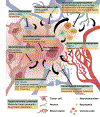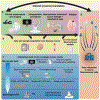Cancer neuroscience: State of the field, emerging directions
- PMID: 37059069
- PMCID: PMC10107403
- DOI: 10.1016/j.cell.2023.02.002
Cancer neuroscience: State of the field, emerging directions
Abstract
The nervous system governs both ontogeny and oncology. Regulating organogenesis during development, maintaining homeostasis, and promoting plasticity throughout life, the nervous system plays parallel roles in the regulation of cancers. Foundational discoveries have elucidated direct paracrine and electrochemical communication between neurons and cancer cells, as well as indirect interactions through neural effects on the immune system and stromal cells in the tumor microenvironment in a wide range of malignancies. Nervous system-cancer interactions can regulate oncogenesis, growth, invasion and metastatic spread, treatment resistance, stimulation of tumor-promoting inflammation, and impairment of anti-cancer immunity. Progress in cancer neuroscience may create an important new pillar of cancer therapy.
Copyright © 2023 The Author(s). Published by Elsevier Inc. All rights reserved.
Conflict of interest statement
Declaration of interests M.M. holds equity in MapLight Therapeutics. M.M. and H.S.V. report the patent (US Patent #10,377,818) “Method for treating glioma.” F.W. and W.W. report the patent (WO2017020982A1) “Agents for use in the treatment of glioma.” F.W. is a co-founder of DC Europa Ltd (a company trading under the name Divide & Conquer) that is developing new medicines for the treatment of glioma. Divide & Conquer also provides research funding to F.W.’s lab under a research collaboration agreement.
Figures





References
Publication types
MeSH terms
Grants and funding
- U19 CA264504/CA/NCI NIH HHS/United States
- P50 CA093459/CA/NCI NIH HHS/United States
- R01 CA258384/CA/NCI NIH HHS/United States
- DP1 NS111132/NS/NINDS NIH HHS/United States
- R01 CA263500/CA/NCI NIH HHS/United States
- R01 NS092597/NS/NINDS NIH HHS/United States
- R01 DE032018/DE/NIDCR NIH HHS/United States
- R35 CA210088/CA/NCI NIH HHS/United States
- R37 CA242006/CA/NCI NIH HHS/United States
- R35 NS097211/NS/NINDS NIH HHS/United States
- R01 CA261939/CA/NCI NIH HHS/United States
- R00 CA252001/CA/NCI NIH HHS/United States
- P50 CA165962/CA/NCI NIH HHS/United States
LinkOut - more resources
Full Text Sources
Medical

